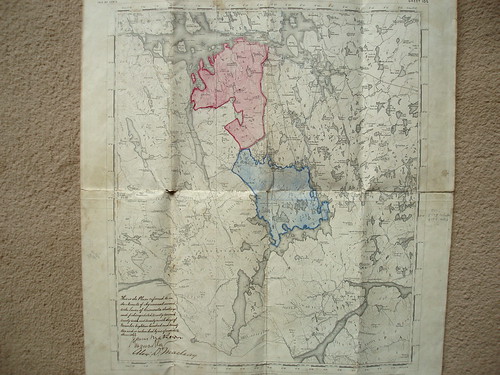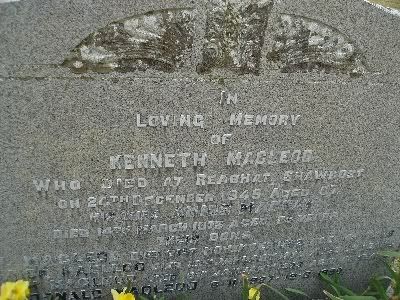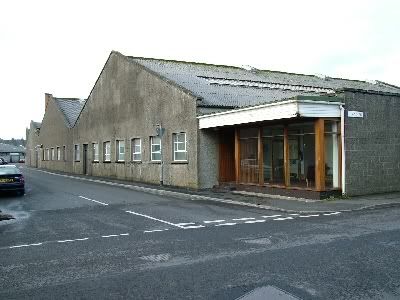1 March 1916 - Groningen, Holland
The 1,500 men of the Royal Naval Division have been interned in this northern city since late 1914. Among them are just over 100 men from the Isle of Lewis. Donald Macleod is one of them. He was born in the village of Gearrannan near Carloway in December 1891. Donald was in the 1st Royal Naval Division, Benbow Battallion. His former schoolmaster at the Nicolson Institute, Mr Gibson, wrote him a Christmas card at the camp in December 1915. Donald replied on 2nd January 1916, extending best wishes to teachers and pupils at his school. He also expressed the wish that Holland would go to war, which would release his companions in Benbow Battallion and himself back into service for Great Britain.
On 1 March 1916, Donald was lying ill in the University Hospital. He died of pleurisy that day. A collection is held among the burghers of Groningen to buy a huge Celtic cross, out of sympathy with this lad of only 24, who died so far away from home. His mates from D company, Benbow Battallion have organised a huge wreath, in the shape of an anchor.
On passing along Groningen’s main street, people stop and bare their heads. Shopworkers stand outside their premises, residents outside their doors, including maids and servants. The cortege finally pulls up at the Southern Cemetery, where Donald is laid to rest.
Donald’s wish was not to be granted. Benbow, Drake, Collingwood and Hawke Battallions were to remain interned until the Armistice, in November 1918. Those that returned to the island after the war would not readily speak of their experiences. They felt it a matter of shame that they had led the ‘cushy life’ of an internment camp, where their fathers, brothers and sons had fought and died in the trenches or in the North Atlantic.
Two more Lewismen would not return home, but lie buried at Groningen: John MacLeay, of Shader, Barvas and John Smith of Lower Bayble. A fourth, Angus MacLeod of Portnaguran, was discharged home for being unserviceable - suffering from pulmonary tuberculosis. He died at Plymouth.
There are suggestions that four internees from Lewis perished in the Iolaire disaster of 1919, when the ship returning them to the island foundered outside Stornoway Harbour.
Saturday, 25 August 2007
Friday, 24 August 2007
Grimersta
I recently found an old, linen-backed map of central Lewis, showing the Grimersta Estate. This stretches between Loch Roag (south of Great Bernera) and Loch Langabhat. The map was part of an arrangement between James Matheson and others over shooting and fishing rights on the estate. The map is annotated with coloured sections, stretching from the northern shores of Loch Langabhat, from Loch Coire Geurad to the current B8011 Uig road (marked in blue) and north from the road to the shores of Loch Barraglom, south of Great Bernera (marked in red). Other sections, demarkated in dotted blue, stretch from the Grimersta River westward, and include the island of Great Bernera.
The map itself is endorsed with the text:
This is the plan referred to in the Minute of Agreement annexed to the Lease of Grimersta shootings and fishings, dated twenty second, twenty sixth and twenty ninth days of November Eighteen hundred and seventy two and is subscribed by us of even date therewith.
Signed by James Matheson, Alex D. MacLeay and a signature I cannot decipher.

The map itself is endorsed with the text:
This is the plan referred to in the Minute of Agreement annexed to the Lease of Grimersta shootings and fishings, dated twenty second, twenty sixth and twenty ninth days of November Eighteen hundred and seventy two and is subscribed by us of even date therewith.
Signed by James Matheson, Alex D. MacLeay and a signature I cannot decipher.

Tuesday, 31 July 2007
Face from the Lewis War Memorial
This is Private MURDO MACKAY

Murdo last lived in Lewis at 2 Achmore,
He was the son of Norman and Catherine MackayHe served in 1st Battallion, Cameron HighlandersService no: 3/5432He died on 22 December 1914RIPHe is remembered on the memorial at Le Touret, on panels 41 and 42His name is mentioned on the Lewis War Memorial, under Lochs on plaque 1
Murdo Mackay is a casualty of the First World War. His name ranks amongst about 1,200 on the Lewis War Memorial, which stands just north of Stornoway, on a prominent hill - you can’t miss it when you enter the town from another part of the island.
When the Great War broke out, some 6,000 islanders entered service with His Majesty’s Armed Forces. That is every second man. One out of every five or six who joined up made the ultimate sacrifice. They were lost in the mud of the trenches, to the U-boats or in the heat of the Arabian desert of what is now Iraq. Another two hundred were lost at a stroke when the Admiralty Yacht “Iolaire” foundered on the Beasts of Holm on 1 January 1919, the third worst maritime disaster in peacetime in the 20th century.
“Faces from the War Memorial“ shows the casualties from the Great War, who originated from Lewis, with a portrait where available. Work is still in progress, and about half of the 400 portraits currently available still need to be incorporated. Additional details are also still being compiled. A claim to completeness cannot be made. A list of maritime casualties is available until the end of this week at the Maritime Exhibition in Stornoway Town Hall. I have been advised that army casualties are not possible to totally verify, as some have fallen unbeknown but unto God.
The “Faces” project was compiled from Loyal Lewis, Roll of Honour 1914-18, the Commonwealth War Graves Commission and with help from Stornoway Historical Society and allied researchers.

Murdo last lived in Lewis at 2 Achmore,
He was the son of Norman and Catherine MackayHe served in 1st Battallion, Cameron HighlandersService no: 3/5432He died on 22 December 1914RIPHe is remembered on the memorial at Le Touret, on panels 41 and 42His name is mentioned on the Lewis War Memorial, under Lochs on plaque 1
Murdo Mackay is a casualty of the First World War. His name ranks amongst about 1,200 on the Lewis War Memorial, which stands just north of Stornoway, on a prominent hill - you can’t miss it when you enter the town from another part of the island.
When the Great War broke out, some 6,000 islanders entered service with His Majesty’s Armed Forces. That is every second man. One out of every five or six who joined up made the ultimate sacrifice. They were lost in the mud of the trenches, to the U-boats or in the heat of the Arabian desert of what is now Iraq. Another two hundred were lost at a stroke when the Admiralty Yacht “Iolaire” foundered on the Beasts of Holm on 1 January 1919, the third worst maritime disaster in peacetime in the 20th century.
“Faces from the War Memorial“ shows the casualties from the Great War, who originated from Lewis, with a portrait where available. Work is still in progress, and about half of the 400 portraits currently available still need to be incorporated. Additional details are also still being compiled. A claim to completeness cannot be made. A list of maritime casualties is available until the end of this week at the Maritime Exhibition in Stornoway Town Hall. I have been advised that army casualties are not possible to totally verify, as some have fallen unbeknown but unto God.
The “Faces” project was compiled from Loyal Lewis, Roll of Honour 1914-18, the Commonwealth War Graves Commission and with help from Stornoway Historical Society and allied researchers.
Tuesday, 24 July 2007
This statue, entitled Exiles, was unveiled by First Minister Alex Salmond yesterday, at Helmsdale on the east Sutherland coast. It shows a family, leaving their homes for a new life overseas. Helmsdale lies at the mouth of the Strath of Kildonan, one of many valleys in Sutherland cleared of their residents in the 19th century. The full background story can be read here.
Whilst I applaud the efforts of Mr Macleod (who initiated the project) to keep the memory of the Clearances alive, I somehow find the positive gloss being cast on this appalling episode in Scotland’s history very, very difficult to stomach. Particularly, bearing in mind Mr Salmond’s political hue, I would have expected to hear rather stronger language than “deplorable”.
Thousands of people were forced by means fair and foul to leave their homes - the practice of burning the thatch over people’s heads is well documented. The Isle of Skye, 35 miles south of here, has been the scene of some atrocious evictions. Late last year, the assertion was being made that the Isle of Lewis had suffered relatively lightly under the Clearances. Well, I couldn’t disagree more.
The below map shows the district of Eishken and the 27 villages which used to be there until 1820.

They were all cleared, mostly to other places within Lewis. But still a forcible eviction.
I agree that the people who were cleared out of northern Scotland did make a contribution in the areas where they settled. But I think it is a stinging indictment that their contribution was not appreciated in their homecountry, and I am waiting for the First Minister to say something about that too.
Labels:
clearance,
pairc,
sutherland
Tuesday, 3 July 2007
Gloup Disaster
I was listening to a program on BBC Scotland about the Gloup Disaster. This occurred on 20 July 1881, and claimed the lives of 36 fishermen from the Isle of Yell in Shetland. As the 126th anniversary is coming up, I would like to dedicate this entry to their memory. Although I am obviously blogging from Lewis, the theme is common to many island communities.
Following a period of bad weather, a clearance prompted the fishermen of Gloup to take to the fishing grounds, 40 miles out to the west. Unbeknown to them, a summer storm raced towards Shetland and fell ont hem with hurricane force winds. Many boats were found overturned with no sign of life.
Fifty-eight fishermen drowned, 36 of whom came from Gloup. They left 34 widows and 85 orphans.
Following a period of bad weather, a clearance prompted the fishermen of Gloup to take to the fishing grounds, 40 miles out to the west. Unbeknown to them, a summer storm raced towards Shetland and fell ont hem with hurricane force winds. Many boats were found overturned with no sign of life.
Fifty-eight fishermen drowned, 36 of whom came from Gloup. They left 34 widows and 85 orphans.
Tuesday, 3 April 2007
Graveyard
I have been going round a few of the island’s cemeteries in recent times, looking for and photographing tombstones of victims of the Iolaire Disaster in 1919. On my visit to Bragar’s cemetery this week, I came across the tombstone for Kenneth MacLeod of Shawbost, an important figure in the Harris Tweed industry. He died in 1949 at the age of 67.

Standing there on a cloudy, windswept day, the news came back to me about ongoing developments in the industry today. And what would he make of it now? Mr Macleod got local weavers to weave tweed for him in the first half of the 20th century.
Late in 2006, Yorkshire industrialist Brian Haggas bought over the remaining Harris Tweed mills in Lewis, of which the largest stands in Stornoway. Shortly beforehand, the closure of the mill in North Shawbost was announced, with the loss of about 30 jobs. Last week, plans were announced to shrink the range of tweeds to 5, although not directly in such words. The announcement was to the effect that single-width weavers would be laid off. Not many of them left, but it was seen as a sign on the wall. Some 20 years ago, there were hundreds if not thousands of different tweeds in circulation. It was a top of the range product. Fears are now being expressed that this prestige will be lost.
It sounds as if Harris Tweed is heading for its own graveyard in history.

On a related note, I came across streets of derelict business premises in the Newton area of Stornoway. This used to be the centre of the Harris Tweed industry in years gone by, but is now broadly in disuse. A line in the recent Budget caught my attention, as the tax on disused business premises was due to be increased, or words to that effect.
I am surprised that the non-residential side of Newton is allowed to fall into ruin like it is at the moment. I hope that following the local council elections on May 3rd someone will have the foresight to come up with a plan for a major revamp of the area. Yes, I am aware that a number of businesses are thriving there

Standing there on a cloudy, windswept day, the news came back to me about ongoing developments in the industry today. And what would he make of it now? Mr Macleod got local weavers to weave tweed for him in the first half of the 20th century.
Late in 2006, Yorkshire industrialist Brian Haggas bought over the remaining Harris Tweed mills in Lewis, of which the largest stands in Stornoway. Shortly beforehand, the closure of the mill in North Shawbost was announced, with the loss of about 30 jobs. Last week, plans were announced to shrink the range of tweeds to 5, although not directly in such words. The announcement was to the effect that single-width weavers would be laid off. Not many of them left, but it was seen as a sign on the wall. Some 20 years ago, there were hundreds if not thousands of different tweeds in circulation. It was a top of the range product. Fears are now being expressed that this prestige will be lost.
It sounds as if Harris Tweed is heading for its own graveyard in history.

On a related note, I came across streets of derelict business premises in the Newton area of Stornoway. This used to be the centre of the Harris Tweed industry in years gone by, but is now broadly in disuse. A line in the recent Budget caught my attention, as the tax on disused business premises was due to be increased, or words to that effect.
I am surprised that the non-residential side of Newton is allowed to fall into ruin like it is at the moment. I hope that following the local council elections on May 3rd someone will have the foresight to come up with a plan for a major revamp of the area. Yes, I am aware that a number of businesses are thriving there
Friday, 23 March 2007
Lewis railways
Lewis did have railways, around the turn of the 19th/20th century. There was a railway from the quarry at Bennadrove to Stornoway. Posts related to this track can still be found in the Castle Grounds, opposite the Caberfeidh Hotel.
A trackbed was laid near Garrabost in Point, but a railway was never built. The same fate befell the track, linking Carloway to Stornoway along what is now the Pentland Road. It was a plan conceived by Lord Leverhulme, who also envisaged lines from Stornoway down to Lochs and Tarbert, as well as over to the West Side. None of these ever came to be.
A trackbed was laid near Garrabost in Point, but a railway was never built. The same fate befell the track, linking Carloway to Stornoway along what is now the Pentland Road. It was a plan conceived by Lord Leverhulme, who also envisaged lines from Stornoway down to Lochs and Tarbert, as well as over to the West Side. None of these ever came to be.
Saturday, 20 January 2007
The Vaila Disaster, 1957
On 6 January 1957, the Fisheries Protection cruiser Vaila ran aground on Eilean Iubhard, just south of Lemreway in South Lochs at 5.30 am. As the vessel became stuck fast on the rocks, the captain ordered to abandon ship. Three lifeboats were launched, of which two got away safely. The third got fouled and turned over, and several crew ended up in the water. Although the captain was saved, five crew drowned that day. Survivors were brought ashore in Stornoway
The Vaila started life as the Royal Navy Minesweeper HMS Acacia, built at a yard in Ardrossan in 1940. She took part in the Normandy landings off Sword Beach. In 1948, she became the Vaila.
Poignantly, when the news came through to Stornoway that the Vaila had sunk, at 8 am that morning, the authorities were not aware that 5 crew had drowned in the waters of Loch Shell. They thought all would be safe, as they were in fairly calm waters. Lifeboat was proceeding to the scene.
Source: National Archive for Scotland through Google.
The Vaila started life as the Royal Navy Minesweeper HMS Acacia, built at a yard in Ardrossan in 1940. She took part in the Normandy landings off Sword Beach. In 1948, she became the Vaila.
Poignantly, when the news came through to Stornoway that the Vaila had sunk, at 8 am that morning, the authorities were not aware that 5 crew had drowned in the waters of Loch Shell. They thought all would be safe, as they were in fairly calm waters. Lifeboat was proceeding to the scene.
Source: National Archive for Scotland through Google.
Subscribe to:
Posts (Atom)

